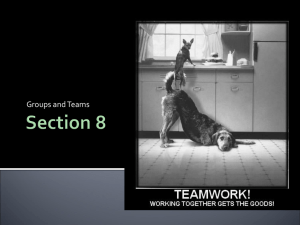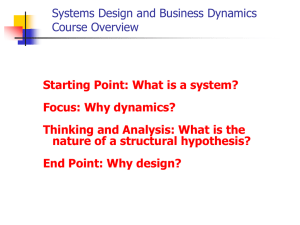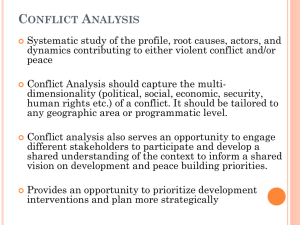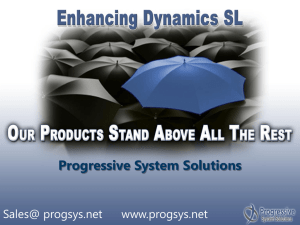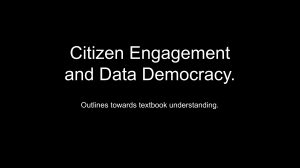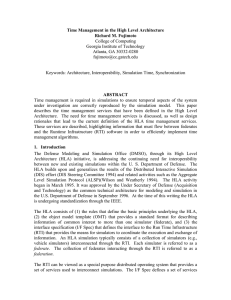Architecture Modeling
advertisement
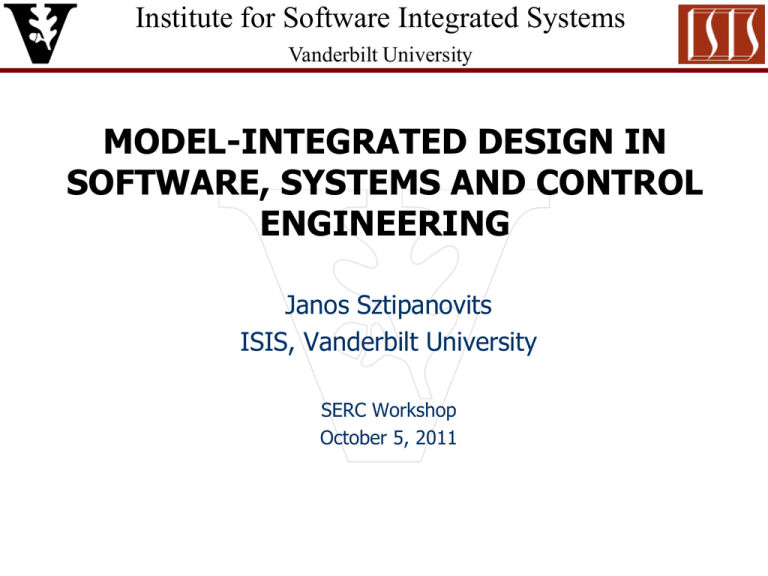
Institute for Software Integrated Systems Vanderbilt University MODEL-INTEGRATED DESIGN IN SOFTWARE, SYSTEMS AND CONTROL ENGINEERING Janos Sztipanovits ISIS, Vanderbilt University SERC Workshop October 5, 2011 Model-Based Design Tools Key Idea: Use models in domain-specific design flows and ensure that final design models are rich enough to enable production of Domain Specific artifacts with sufficiently predictable properties. Design Automation Impact: significant productivity increase in design technology Environments: • Automotive • Avionics • Sensors… Domain-Specific Environments Design Requirements Tools: • Modeling • Analysis • Verification • Synthesis Challenges: • Cost • Benefit only narrow domains • Island of Automation doTransition (fsm as FSM, s as State, t as Transition) = require s.active step exitState (s) step if t.outputEvent <> null then emitEvent (fsm, t.outputEvent) step activateState (fsm, t.dst) Mathematical and physical foundations Production Facilities Metaprogrammable Design Tools Key Idea: Ensure reuse of high-value tools in domain-specific design flows by introducing a metaprogrammable tool infrastructure. Domain Specific VU-ISIS implementation: Model Integrated Computing (MIC) tool Design Automation suite (http://repo.isis.vanderbilt.edu/downloads/) Environments: • Automotive • Avionics • Sensors… Metaprogrammable Tool Infrastructure • Model Building • Model Transf. • Model Mgmt. • Tool Integration Explicit Semantic Foundation • Structural • Behavioral Domain-Specific Environments Design Requirements Semantic Backplane Metaprogrammable Tools, Environments doTransition (fsm as FSM, s as State, t as Transition) = require s.active step exitState (s) step if t.outputEvent <> null then emitEvent (fsm, t.outputEvent) step activateState (fsm, t.dst) Production Facilities Semantic Foundation Component Libraries Use Case 1: Cyber Physical Systems Engine Transmission ISG Battery VMS Servos /Linkages Physical Functional: implements some function in the design Interconnect: acts as the facilitators for physical interactions Cyber Computation and communication that implements some function Requires a physical platform to run/to communicate Components span: • Multiple physics • Multiple domains • Multiple tools Cyber-Physical Physical with deeply embedded computing and communication DARPA AVM Program CPS Design Flow Requires Model Integration Architecture Design Modeling Exploration Integrated Multi-physics/Cyber Design Modeling Simulation V&V Detailed Design Modeling Analysis SW Physics-based Rapid exploration • • • Architecture Modeling Design Space + Constraint Modeling Low-Res Component Modeling Structure/CAD/Mfg Exploration with integrated optimization and V&V • • • • • • Architecture Modeling Design Space + Constraint Modeling Dynamics Modeling (ODE) Computational Behavior Modeling CAD/Thermal Modeling Manufacturing Modeling • • • Deep analysis Architecture Modeling Dynamics, RT Software, CAD, Thermal, … Detailed Domain Modeling (FEM) Domain Specific Modeling Languages Model Integration Challenge: Physics Heterogeneity of Physics Electrical Domain Mechanical Domain Hydraulic Domain Thermal Domain Theories, Dynamics, Tools Theories, Dynamics, Tools Theories, Dynamics, Tools Theories, Dynamics, Tools Physical components are involved in multiple physical interactions (multiphysics) Source of resilience: explicit modeling of multi-physics interactions. Model Integration Challenge: Implementation Layers Plant Dynamics Models Controller Models Heterogeneity of Abstractions Physical design Software Architecture Models Software Component Code Software design System Architecture Models Resource Management Models System/Platform Design Dynamics: B(t ) p ( B1 (t ),..., B j (t )) • Properties: stability, safety, performance • Abstractions: continuous time, functions, signals, flows,… B(i ) c ( B1 (i ),..., Bk (i )) Software : • Properties: deadlock, invariants, security,… • Abstractions: logical-time, concurrency, atomicity, ideal communication,.. B(t j ) p ( B1 (ti ),..., Bk (ti )) Systems : • Properties: timing, power, security, fault tolerance • Abstractions: discrete-time, delays, resources, scheduling, Source of resilience: systems science principles for decoupling across design layers (such as passive dynamics to decouple stability from implementation induced time-varying delays Model Integration Language Model Integration Language (MIL) Semantic Backplane Hierarchical Ported Models /Interconnects Structured Design Spaces Meta-model Composition Operators MIL Pro-E CAD Sem. IF Pro-E abstraction SL/SF Sem. IF abstraction abstraction MIL SL/SF MIL SEER TD Sem. IF Thermal Desktop SEER-MFG MIL CAD CATIA Tools and Frameworks Assets / IP / Designer Expertise Impact: Open Language Engineering Environment Adaptability of Process/Design Flow Accommodate New Tools/Frameworks , Accommodate New Languages Use Case 2: “C2 Wind Tunnel” Mixed Initiative Controller Human Controllers Abstract Commands HCI Coordination Context Dep. Command Interpretation Adaptive Resource Allocation Platform Commands Decision Support Assigned Platform Commands Platform Status Data Distribution Network Model-Based Experiment Integration Environment: C2WT Issues to be studied experimentally: • Distributed Command and Control – Synchronization and coordination – Distributed dynamic decision making – Network effects • Information Sharing – Shared situation awareness – Common Operation Picture (COP) – Network effects • Advanced Cooperative Control – Cooperative search algorithms AFOSR PRET Program Heterogeneous Simulation Integration CPN Processing (Tracking) Controller/Vehicle Dynamics Organization/Coordination Devs SL/SF CPN Adaptive Human Organization Mixed Initiative Controller Context Dep. Command Interpretation 3-D Environment (Sensors) Delta3D Adaptive Resource Allocation How can we integrate the models? How can we integrate the simulated heterogeneous system components? Decision Coordination Support How can we integrate the simulation engines? Abstract Commands HCI COP Elements COP Elements Assigned Platform Commands Platform Commands Platform Status COP Elements Data Distribution Network Model-Integrated System and Software Laboratory Environment: C2 Windtunnel GME Simulation Interaction GME Simulation Architecture OMNET Network Architecture Model Integration Architecture in C2WT Simulator Integration models Dataflow models RTDS Delta3D Delta3D Federate Simulink Simulink Federate(s) HLA-RTI OMNet Federate OMNet CPN Federate CPN G e n e r a t o r s Interaction models Deployment models Simulation Integration Architecture in C2WT Experiment Specification & Configuration Model Integration Layer Controller Models Network Models Simulink Federate OmNet++ Federate Org. Models Fusion Models Env. Models Models Run-time CPN Federate. DEVS Federate. OGRE Federate Instrumentation Layer Layer Instrumentation Simulation Integration Platform (HLA) Simulation Data Distribution/Communication Middleware Distributed Simulation Platform https://wiki.isis.vanderbilt.edu/OpenC2WT Component Models Example: Simulink model integration (Vehicle dynamics) GME integration model Original model (X4 simulator) Add input-output bindings Input binding Code generation Output binding Modified model Generated .m Receiver and Sender S-function code + .java code for representing Simulink federate RTI runtime communication Signal flow Signal flow HLA Run-Time Infrastructure (RTI) Experiments: Impact of Cyber Attacks Network attack: A sub-network with hundreds of zombie nodes attacks a critical router on the main network. Flood attack on udp, tcp or ping Full network Zombie subnet Summary Questions: What are challenging systems application domains? Heterogeneous SoS domains (like CPS and C2). How does practice diverge from theory, and how do we connect? Precise compositionality is hard to achieve in heterogeneous systems, still, we need predictability. Need systems science principles for simplifying interactions and dependences (decoupling). Where are relevant technologies to be found? In cross-disciplinary interactions. E.g. scalability in embedded software verification may require tradeoffs in systems dynamics. What would be the most critical tools and products? Component-based and model-based design approaches and tools are and will be increasingly essential. Example: Architecture Modeling Sublanguage / Capability Architecture Modeling Design Space Modeling Formalism, Language Constructs, Examples Hierarchical Module Interconnect - Components Interfaces Interconnects Parameters Properties Hierarchically Layered Parametric Alternatives - Alternatives/ Options Parameters Constraints Usage Systems Architect - Explore Design Space Derive Candidate Designs Systems Architect - Define Design Space Define Constraint Example: Dynamics Modeling Component Engineer Hybrid Bond Graphs - Physical Dynamics Modeling - - - model dynamics with Hybrid Bond Graphs Efforts, Flows, Sources, Capacitance, Inductance, Resistance, Transformers Gyrators, System Engineers - Compose system dynamics Domain Engineers Dataflow + Stateflow + TT Schedule Computational Dynamics Modeling - Interaction with Physical Components Cyber Components Processing Components - Actuator Sensor Processor Topology Software Assembly Allocation design controller System Engineers - Processor allocate Platform Effects Example: Physical Structure and Manufacturing Modeling Solid Modeling (CAD / Geometry) Structural Interfaces - Defined with Peer Roles: - Axis - Point - Surface - CAD Links Component Manuf. Cost -Make Manufacturing Modeling Material Fab Proc Complxity Shape/Wt -OTS: Cost/unit Structural Interfaces Standard Structural Interfaces (ex: SAE #1) Component Engineer -Defines Structural Interface System Engineer - Defines Architecture Component Engineer -Defines Part Cost -Defines Structural Interface, Fastener -Fastener Types, Num# … 18

